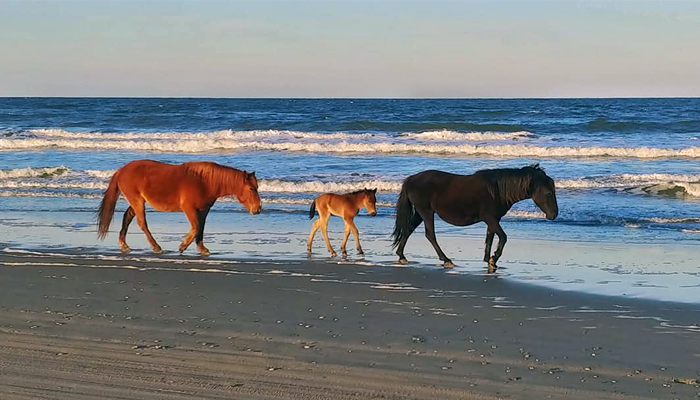Wild Horses on the Outer Banks
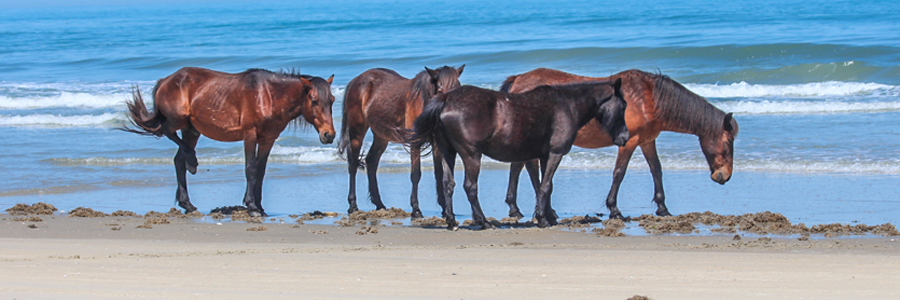
When you come to the beach, the desire to see marine wildlife is understandable. From sea turtles, dolphins, and sharks to crabs, birds, and even the occasional seal, you never know what animal you might encounter while touring these unique barrier islands. One wild animal you might not expect to see however are the wild horses. You may have heard about the Outer Banks wild mustangs that roam the beach in realty ads, magazines, and even popular films but if you’ve never driven up the winding highway to Corolla, you may never have seen them for yourself. Believe us, though, you’re missing out. If you’ve been wondering "What’s with the Outer Banks wild horses?" ...We’ve got the answers.
Wild Horses? What are you talking about?
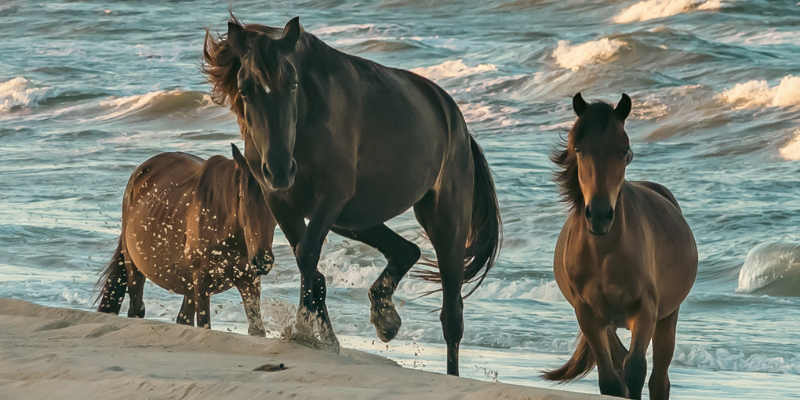
If you're new to the Outer Banks, or just unfamiliar with Corolla in general, you're probably wondering why we're talking about horses at all. But one of the biggest draws for many folks to come to the Outer Banks is the chance to see these wild horses, who are often brown, tan, and black, meandering through the forests and sand dunes of the northern Outer Banks. The Corolla Wild Horses thrive in the 4x4 area of Carova and northern Corolla, where they can be seen running through the sand, grazing on the grasses in the dunes and maritime forest areas, or gathering together in herds and simply existing as part of the landscape. They're truly a beautiful sight and no trip to the Outer Banks is complete without a glimpse of these horses that are just as naturally at home on the Outer Banks as the seagulls and turtles.
Where Did They Come From?
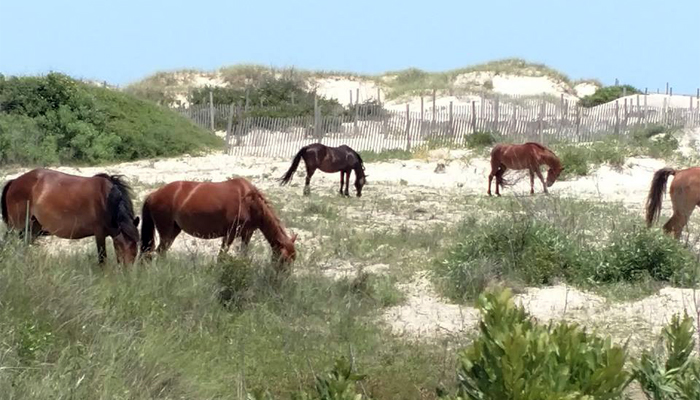
The wild mustangs of Corolla are not native to the Outer Banks but rather were brought to the “New World” by Spanish explorers. Bringing horses overseas was not uncommon during the time of early explorers as documents show Christopher Columbus brought Spanish horses on his voyages to the West Indies in the 1490s. According to ship logs from the 16th century, among the typical products Spaniards traded (like sugarcane), livestock was a major commodity and this included horses. Specifically, the modern Outer Banks wild horses may have descended from breeds that arrived with the expeditions of Lucas Vasquez de Allyon (who likely landed around modern-day Shackleford Banks in 1521) and Richard Greenville (who frequented the Outer Banks coast for trade purposes between 1584 and 1590).
Other theories speculate that Spanish ships that were lost in the treacherous Diamond Shoals, or perhaps ships that were forced to make landfall due to bad weather, may have supplied the population as the horses could have reached land themselves or may have been released and left behind. Either way, the herd thrived enough to maintain a sustainable population and documentation in the historical archives show evidence that the herd was present along the Outer Banks and Shackleford Banks coast all throughout the last few centuries earning them the name “Banker” horse.
About Banker Mustangs
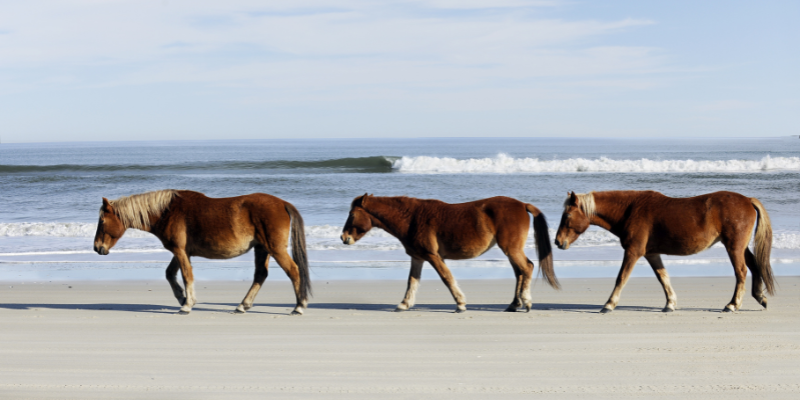
The term “mustang” is a general term used to refer to feral horses in America that are of Spanish descent so the Bankers are often referred to as wild mustangs. Banker horses are believed to have been descendants of the Spanish Barb and Arabian breeds. Arabian horses are known to have one less vertebra than most other horse breeds and Bankers share that same trait. They also feature a mix of the Iberian convex head as well as a concave head shape. Typically, they are smaller in stature and weigh from about 800 to 1,000 pounds at a height rarely exceeding 14 hands. Usually chestnut, bay, or dun in color, the horses tend to be docile in nature and live on Spartina grasses, sea oats, and other native vegetation. Their freshwater sources include rain water and ground water obtained from the digging of small holes. Rescued Bankers that are adopted are known to remain docile with good stamina and are often used for joy riding. Throughout history, Bankers have been used for beach patrols and hauling equipment. In 2010, NC Governor Beverly Perdue designated the Colonial Spanish Mustang as the official North Carolina State Horse.
Bankers are found in Corolla and three other coastal locations. 1) The small herd of Bankers (roughly 15) found in Ocracoke are managed by the National Park Service. As of 1959, the “Ocracoke wild ponies” were penned in to protect them from vehicle interaction and avoid overgrazing in a 180-acre pen. 2) Similar to the Corolla herd, the Shackleford Banks herd sits at a population of around 120-130. Managed by the National Park Service and the Foundation for Shackleford Horses, this herd is protected by federal law and roams freely along 3,000 acres of the Cape Lookout National Seashore. 3) Lastly, a small herd of about 30 – 40 horses can be found at the Rachel Carson National Estuarine Research Reserve in Beaufort. Managed by the state of North Carolina, this herd arrived on the reserve in the 1940s and may have come over from the nearby Shackleford herd or left by residents of the island. In addition, there is a small herd of about 50 horses that freely roam on private land on Cedar Island.
The herd that exists in Corolla today has over 7,500 acres to roam free although that land is shared with homes, roads and people. In 2007, the Horse of the Americas Registry (HOA) determined the Corolla herd was officially eligible for registration as Colonial Spanish Mustangs.
Wild Horse Tours
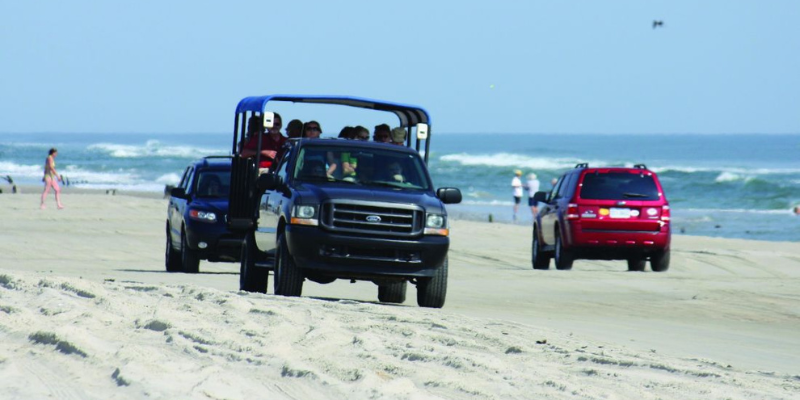
If you want to see these beautiful animals galloping along the beach for yourself, a guided Wild Horse Tour is an excellent way to learn more about the Corolla Banker Mustangs and get some great photo opportunities. While you may spot a horse while lounging on the beach yourself, professional tour guides are able to take you across the bumpy beaches and through unique backtown roads where the horses often frequent, while answering any questions you might have about the herd. You can drive up on the 4x4 area with an appropriate vehicle on your own or you can take a Corolla wild horse tour from a dependable local company like Bob's Wild Horse Tours or Wild Horse Adventure Tours.
How to See the Corolla Wild Horses for Free
One of the easiest ways to catch a glimpse of these wild horses without spending a dime is to drive along the 4x4 area in Corolla or get settled in for a beach day in Carova, where the pavement ends and surf, sand, and sun begin at the beach access ramp at the end of NC-12. From here, you'll head to an area only accessible by four-wheel-drive vehicles - find out more about beach driving here. These areas are open to the public for driving and beach day relaxing and this is also where you can expect to see the horses roaming freely across the dunes and near the shoreline. To make the most of your visit, plan to go during the early morning or late afternoon, when the temperatures are cooler and the horses are more active. Keep your eyes peeled near the dunes and grassy areas, and bring binoculars or a camera with a good zoom lens to observe respectfully from a distance. Be sure to drive slowly, keep a safe distance of at least 50 feet, and never feed the horses—it's not only for both your safety and theirs, but it's also the law.
Helpful Tips for a Safe and Memorable Visit:
Drive a true 4x4 vehicle. AWD or standard SUVs without high clearance can get stuck in the deep sand, meaning you're going to have to call for help. Lower your tire pressure to about 15–20 psi for better traction before entering the sand. There are refill stations available near the access ramp for you to use before returning to the pavement.
Respect the law. It’s illegal to come within 50 feet of the wild horses. Feeding, petting, or attempting to lure them closer can be harmful to both you and the animals - while also earning you a hefty fine.
Watch where you park. Stay off the dunes and park close to the shoreline, but be aware of high tide as it's not uncommon for unaware vehicles to get swept into the surf. Keep one lane open for through traffic at all times while maintaining awareness of emergency vehicles and other beachgoers - including the ones on foot.
Be weather-aware. Rain, storms, and high tides can create difficult and/or dangerous driving conditions. Check tidal charts and the weather forecast before heading out.
Pack essentials. Cell service can sometimes be spotty the further away you get from the pavement, so bring water, sunscreen, snacks, and a first aid kit, and be sure to let someone know your plans before heading out.
Where to Stay to See the Wild Horses
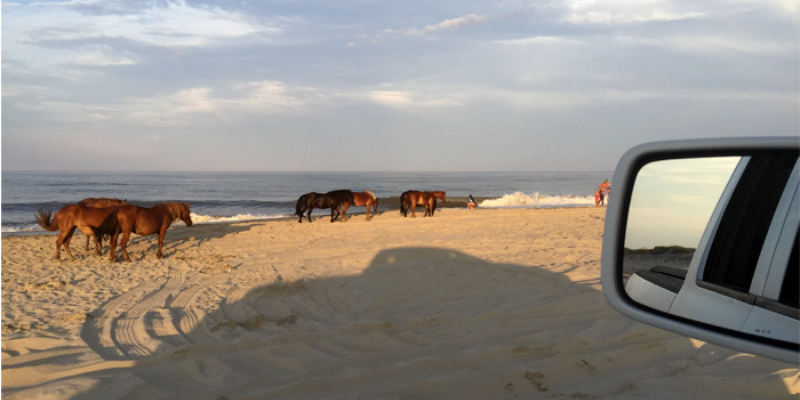
The Corolla Wild Horses can be predominantly found in northern Corolla and Carova, up on the 4x4 beaches. This is the area of the Outer Banks where the road ends and travelers must air down their tires to navigate this stretch of largely undeveloped beach.
If you're looking for ease of access to both these types of tours and the 4x4 area, consider staying in one of our beautiful Corolla homes. We've got over 100 homes in Corolla to choose from, stretching all the way from the area right where the 4x4 begins down to where Corolla becomes Duck. Whether you're looking for a small, oceanside condo to accommodate your small family or a large, lavish retreat for the whole family to enjoy, we've got what you're looking for.
Browse Corolla Vacation Rentals Now
Interacting With the Horses
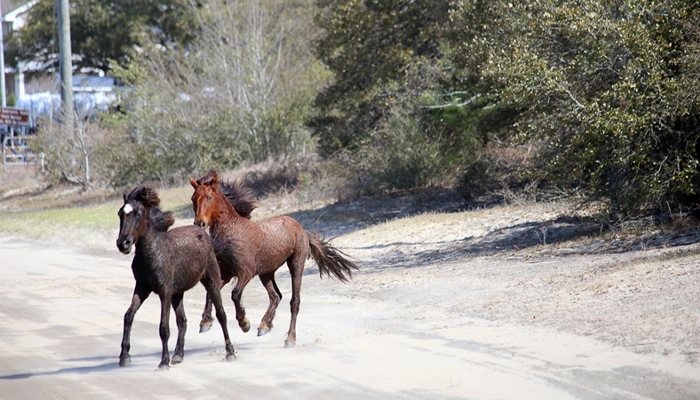
Visitors are highly encouraged to learn about and witness these historic and majestic marvels in the hopes that preservation and conservation efforts will grow. However, it’s imperative for your safety and the safety of the horses that this is done at a safe distance.
Currituck County law addresses human interaction with the wild horses in the Wild Horse Ordinance.
Important items from the ordinance include:
- It shall further be unlawful for any person to lure, attract or entice a wild horse to come within 50 feet of any person or for any person. (Sec. 3-31. – Luring, enticing, seizing)
- It shall be unlawful for any person to molest, torture, torment, cruelly beat, needlessly mutilate or kill, wound, injure, poison or subject to conditions detrimental to its health or general welfare any wild horse within a wild horse sanctuary, or to cause or procure such action. The words "torture" and "torment" shall be held to include every act which causes unjustifiable pain, suffering or death. (Sec. 3-33. – Cruelty)
- It shall be unlawful for any person to feed, ride, pet or approach with the intent to feed, ride or pet any wild horse. (Sec. 3-36. – Feeding, riding and petting prohibited)
These laws are not meant to prevent visitors and locals from enjoying the Banker Mustangs but rather to protect them. With such a small population, even one injury, illness, or death can be very detrimental to the herd. Unfortunately, many visitors do not understand the full extent of their actions by assuming the wild herd enjoys the same treats that a domestic horse would like. Sadly, one treat could easily kill the horse who eats it. Additionally, although they may appear calm and inquisitive, keeping your distance is absolutely necessary, no matter what your experience level is with domestic horses. At the end of the day, the Spanish Banker Mustangs are a feral species meaning they are wild, unpredictable, and potentially dangerous. Here are some additional guidelines to follow when you are observing or come in contact with the Corolla wild horses:
- REPORT: If you spot a sick or injured horse, report it to the Corolla Wild Horse Fund or the Currituck County sheriff’s dispatch. Do not try to help the horse as it could injure you or be further injured itself. If you see someone violating an ordinance, report the incident to the Currituck County sheriff immediately.
- OBSERVE: Never come within 50 feet of a wild horse or herd of wild horses. If you are approached by a group of wild horses on the beach, please respect their space and move away per the ordinance.
- RESPECT: Never feed a wild horse. Fruits, vegetables and other snacks can cause extremely dangerous digestive issues that could be fatal.
- PRESERVE: If you would like to get involved in conservation efforts, please visit the Corolla Wild Horse Fund’s website to learn more about making a donation, becoming a member, sponsoring a horse, or volunteering.
Wild Horse Fund
Formed in 1989, the Corolla Wild Horse Fund (CWHF) was developed to preserve and protect the Banker Mustangs of North Carolina which are deemed as Critically Endangered by The Livestock Conservancy. It wasn’t until 2006 that the organization even had full-time staff so almost all preservation work over the years has been achieved by passionate volunteers eager to preserve a unique part of our state’s history. To manage the population, a Herd Manager documents each horse in a database by using identifiable markers like color and other markings. Field observation is combined with an aerial helicopter count to determine the current herd population. The target population is between 120 and 130 as it is large enough to sustain the population while still preventing other dangers like overgrazing. A population of less than 110 means the horse could be in danger of becoming extinct.
Part of the fund’s goal is to educate visitors about the wild horses. Unlike domestic breeds, Banker horses must maintain a very strict diet and are not equipped to eat fruits and vegetables. When visitors feed a wild horse a snack that a domestic horse might eat, they are putting the horse in very great danger of terrible digestive side effects that could be potentially fatal.
When a horse is injured or falls ill, the CWHF will bring in equine vets to treat horses in the field when at all possible. Bankers are not able to be removed from their habitat and kept among domestic horses fore care and then returned to the wild due to the risk of spreading a domestic disease to the wild herd who lack immunity to surive the illness. In addition, horses brought to a care center are also more likely to approach humans due to the human interaction which is very dangerous for the wild herd. If not possible to treat them in field, there are cases when a horse is too ill so CWHF must capture the horse and care for them in a rehabilitation center. Those who make full recovery are available for adoption and are housed at a 21-acre facility in Grandy.
Seaside Vacations is proud to partner with the Corolla Wild Horse Fund as a CWHF Community Cares Partner. By partnering with the Corolla Wild Horse Fund, we aim to ensure these beautiful creatures continue to thrive for generations to come. Together, we can safeguard this cherished piece of Outer Banks heritage and inspire visitors and locals alike to cherish the natural wonders of our home.
In The News
November 6, 2024: Remembering Raymond
July 29, 2024: Fatal Wild Horse Incident
May 8, 2024: Elvis has arrived!
Frequently Asked Questions
Where are the Corolla Wild Horses located on the Outer Banks?
The wild horses commonly known as the "Corolla Wild Horses" primarily live on the northern Outer Banks in the areas of Corolla and Carova.
Can I touch, feed, ride, etc. the wild horses?
No. It is illegal to feed the wild horses and there is a county ordinance making it illegal to come within 50 feet of the wild horses.
What should I do if I see an injured horse?
Remaining at least 50 feet away, try to take a picture of the animal then call the Corolla Wild Horse Fund at (252) 453-8002 during business hours. If outside of business hours, please call Currituck County Dispatch at (252) 453-3633.
Do NOT attempt to interfere with, touch, or provide to the wild horse under and circumstances.
What is the best way to see the Corolla Wild Horses?
The best way to see them is to take a guided tour through a local company, though you may see them while casually driving the 4x4 area. If you choose to drive on the beach, please be aware of your surroundings and be careful to avoid injuring the horses by following all locally posted laws, speed limits, and guidelines. For more information about beach driving, check out our guide here.
Who takes care of the horses?
As the horses are wild animals, they are a part of the landscape and live in the same way as other wildlife such as deer or birds. The Corolla Wild Horse Fund is responsible for monitoring and protecting the Corolla Wild Horse population.
Book Now for an Unforgettable Experience
Book your stay today in one of our cozy vacation rentals and explore all the best and brightest that the Outer Banks has to offer. Give our wonderful Guest Services Team a call today at (866) 884-0267 or take a look at our available rentals to get started planning your next unforgettable adventure to the Outer Banks. There so much to do and see. With amazing food and drinks, exciting excursions, and plenty of sand for everyone to relax, there's something for everyone here on the Outer Banks.
And don't forget about our layaway plan, which makes booking your dream vacation easier than ever. So don't wait. We're booking Outer Banks vacation rentals year round and we're excited to help you create memories to last a lifetime. We're here to help make your OBX vacation fun, exciting, and hassle-free. Give us a call today! Be sure to provide accurate information and make any necessary payments.
FIND THE PERFECT VACATION HOME BY CATEGORY:
- Dog-Friendly Rentals
- Oceanfront Rentals
- Rentals with a Private Pool
- New to Seaside
- Group Travel and Event Homes
- Any Day Stays
Or by City:
Explore our website and give us a call to help kick-start your unforgettable Outer Banks vacation today. Be sure to follow us on Facebook, Instagram, YouTube, Pinterest, and TikTok to stay up to date on all of our specials, new & featured homes, and tips & tricks for making the most of your next Outer Banks vacation.
We’ll see you at the beach.



